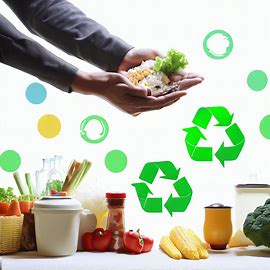
Are you tired of constantly throwing away spoiled food and wasting your hard-earned money?
Do you want to learn how to preserve your food and extend its shelf life? Look no further!
In this beginner's guide to food preservation techniques, we will explore simple and effective ways to keep your food fresh and save you money in the long run.
From canning and pickling to freezing and drying, we will walk you through each method step-by-step, providing helpful tips along the way.
Whether you're a seasoned pro or a novice in the kitchen, this guide is perfect for anyone looking to reduce food waste and stretch their grocery budget.
So, let's get started on the journey to preserving your food and saving money!
Food preservation has been around for centuries, and for good reason.
One of the biggest benefits of preserving your food is that it extends its shelf life, allowing you to enjoy it for longer periods of time.
This is especially important if you have a large family or if you live in a remote area where grocery stores are not easily accessible.
Additionally, preserving your food can help you save money by allowing you to take advantage of seasonal produce when it's at its cheapest and most abundant.
Another benefit of preserving food is that it can help reduce food waste.
According to the United States Department of Agriculture, Americans waste between 30-40% of their food supply each year.
By preserving your food, you can help reduce this number and do your part to minimize food waste.
Finally, preserving your food can also be a fun and rewarding hobby. Not only will you be able to enjoy your homemade preserves, but you can also share them with family and friends.
There are several methods for preserving food, each with its own unique benefits and drawbacks.
Some of the most common methods include canning, freezing, drying, pickling, and fermentation. Let's take a closer look at each of these techniques and how they work.
### Canning: Basics and Step-by-Step Guide
Canning is a popular method for preserving fruits, vegetables, and meats.
The process involves heating food in jars to create a vacuum seal, which prevents the growth of bacteria and other microorganisms.
The two most common types of canning are water bath canning and pressure canning.
Water bath canning is ideal for high-acid foods such as fruits, tomatoes, and pickles, while pressure canning is recommended for low-acid foods such as vegetables, meats, and fish.
To get started with water bath canning, you'll need a large pot, jars with lids and bands, and a jar lifter.
Here's a step-by-step guide to water bath canning:
1. Wash your jars, lids, and bands in hot, soapy water and rinse them thoroughly.
2. Fill your canner with enough water to cover your jars by at least 1 inch and bring it to a simmer.
3. Pack your food into the jars, leaving a ½ inch of headspace at the top.
4. Remove any air bubbles by gently tapping the jars on a hard surface.
5. Wipe the rims of the jars with a clean, damp cloth and place the lids and bands on top.
6. Using your jar lifter, place the jars into the canner, making sure they are covered by at least 1 inch of water.
7. Bring the water to a rolling boil and process the jars for the recommended amount of time based on your recipe.
8. Using your jar lifter, remove the jars from the canner and place them on a towel to cool.
9. Once the jars have cooled, check the seals by pressing down on the center of the lid. If it doesn't flex, the jar is properly sealed.
### Freezing: How to Freeze Food Properly
Freezing is a convenient and easy way to preserve food.
It works by slowing down the growth of microorganisms and enzymes, which can cause food to spoil.
To freeze food properly, you'll need a few basic supplies, including freezer bags, airtight containers, and a freezer thermometer.
Before freezing your food, make sure it is fresh and in good condition. Blanching vegetables before freezing can help preserve their color and texture.
When freezing meat or fish, remove any excess fat or bones to prevent freezer burn.
To freeze food properly, follow these steps:
1. Clean and prepare your food as needed.
2. Place the food in a freezer bag or airtight container, leaving enough space for the food to expand as it freezes.
3. Label the container with the date and contents.
4. Place the container in the coldest part of your freezer, which is usually the back.
5. Check the temperature of your freezer regularly to ensure it is at 0°F or below.
### Drying: Methods and Tips
Drying is a traditional method of preserving food that involves removing moisture from the food.
This can be done using a dehydrator, an oven, or even the sun. Dried foods can be stored for several months and are great for snacking or adding to recipes.
To dry food properly, follow these tips:
1. Slice your food thinly and evenly.
2. Blanch vegetables before drying to help preserve their color and texture.
3. Arrange the food in a single layer on a dehydrator tray or baking sheet.
4. Set the temperature to the recommended setting and let the food dry for several hours.
5. Check the food regularly and remove any pieces that are dry.
### Pickling: What It Is and How to Do It
Pickling is a method of preserving food that involves soaking it in a brine made of vinegar, water, and salt.
This not only extends the shelf life of the food but also gives it a tangy and flavorful taste. Pickling is commonly used for vegetables such as cucumbers, carrots, and onions.
To pickle food, follow these steps:
1. Clean and slice your vegetables.
2. Combine vinegar, water, and salt in a pot and bring it to a boil.
3. Add any additional seasonings such as garlic, dill, or mustard seeds.
4. Pack the vegetables into a jar and pour the hot brine over them.
5. Let the jar cool to room temperature and then store it in the refrigerator.
### Fermentation: Benefits and How-To Guide
Fermentation is another method of preserving food that involves using beneficial bacteria to convert sugars and starches into lactic acid.
This not only extends the shelf life of the food but also provides health benefits such as improved digestion and immunity.
Fermentation is commonly used for foods such as sauerkraut, kimchi, and yogurt.
To ferment food, follow these steps:
1. Clean and slice your vegetables.
2. Mix the vegetables with salt and pack them into a jar.
3. Add water to the jar so that the vegetables are fully submerged.
4. Place a weight on top of the vegetables to keep them submerged.
5. Cover the jar with a lid or cloth and let it sit at room temperature for several days.
6. Check the jar daily and remove any scum that forms on the surface.
7. Once the fermentation process is complete, store the jar in the refrigerator
No matter which method of food preservation you choose, there are a few tips that can help ensure success.
First, always use fresh, high-quality ingredients.
Second, follow the recipe or instructions carefully to ensure the correct ratios of ingredients and processing times.
Third, make sure your equipment is clean and in good condition.
Finally, always label your preserved foods with the date and contents so that you can keep track of what you have and when it was preserved.
The equipment needed for food preservation will depend on the method you choose.
For canning, you'll need a large pot, jars with lids and bands, and a jar lifter.
For freezing, you'll need freezer bags, airtight containers, and a freezer thermometer.
For drying, you'll need a dehydrator, an oven, or the sun.
For pickling, you'll need a pot, jars, and airtight lids.
For fermentation, you'll need a jar, weight, and lid or cloth.
Preserving your food is not only a great way to save money, but it's also a fun and rewarding hobby.
With a little practice and the right equipment, anyone can learn how to preserve their food and reduce food waste.
Whether you choose canning, freezing, drying, pickling, or fermentation, each method has its own unique benefits and can help extend the shelf life of your food.
So, give it a try and see how much money you can save!
